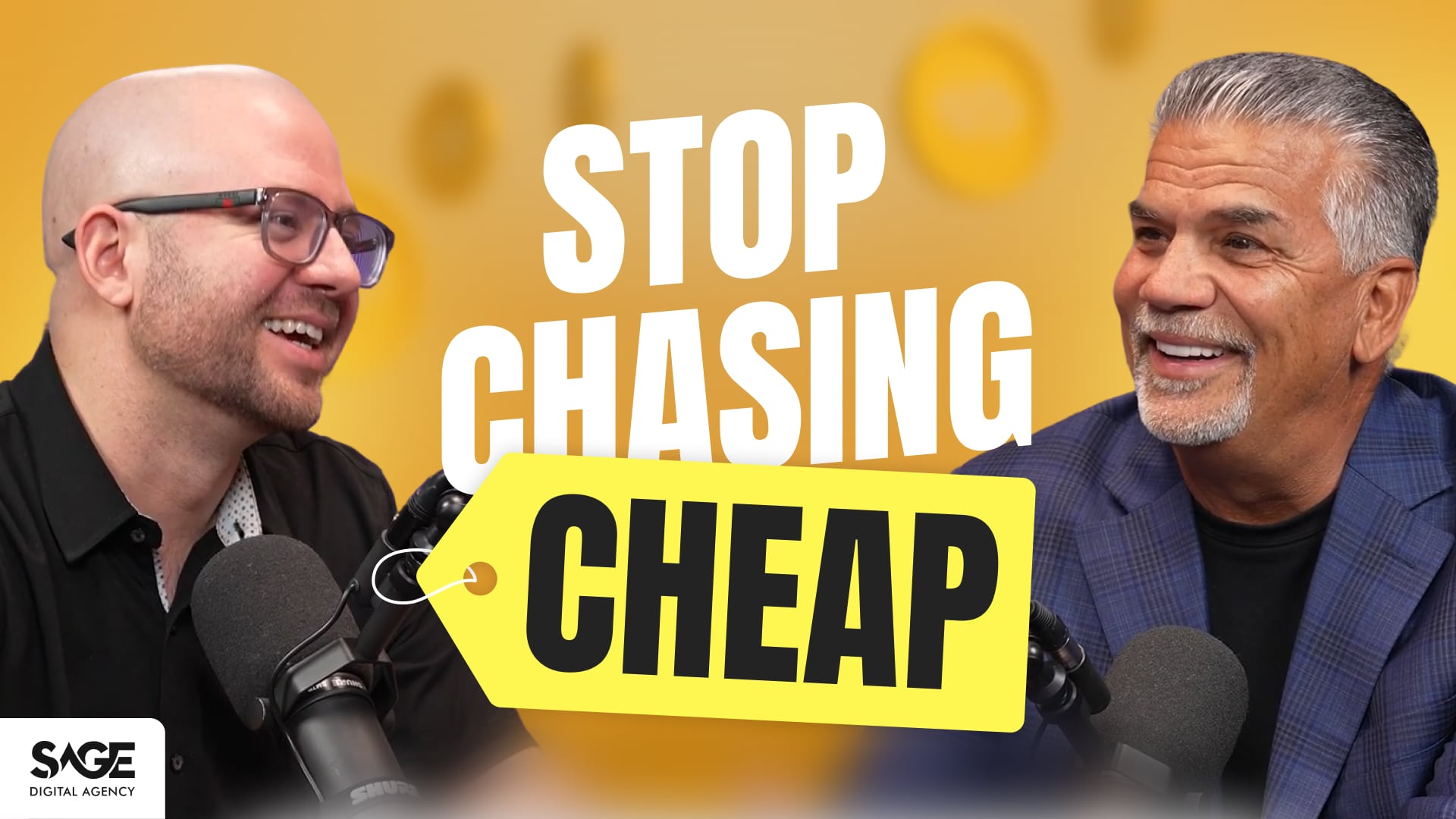Why Business Owners Keep Choosing Cheap Vendors (And Paying For It Later)
I take a lot of sales calls. Hundreds of them over the years. After 13 years in this business, I’ve started recognizing patterns.
The same stories keep coming up. Different people, different industries, but the plot is always familiar. Someone tried to save money on something critical to their business. It failed. They lost money. And now they’re about to do it again.
Let me tell you about a call I had recently that perfectly captures this cycle.
The $25,000 Problem
A business owner reached out to me. She used to do a few million dollars a year in revenue. Now she’s at half that. She has 10 employees counting on her to turn things around.
“I’ve spent $25,000 so far on websites and it’s been a total failure,” she told me. “Look at my current site. I did it myself.”
First mistake right there.
We had a good first conversation. She liked my content, got my emails, said she wanted to work together. I sent over the proposal. A few days later, she called back.
“I committed to having a conversation with one other vendor,” she said. “I’m talking to them on Monday, and after that, we’re going to wrap up and finish our project together.”
No problem. I told her to do whatever she needed to feel confident about her choice. No pressure.
Then I didn’t hear from her for a few more days.
When she finally responded, it was by email. “I talked to this other vendor and they’re telling me the price is approximately 50 or 60% less than what you quoted. And they’re doing all these other add-ons. Unlimited SEO for life. Hosting for 10 years at no additional cost.”
Here’s the kicker: she also mentioned they’d done a mockup for her. She didn’t like it at all.
So my question back to her was simple: “What does the price matter if the product sucks?”
Chase Cheap, Get Cheap
There’s an old saying that fits here perfectly: chase cheap, get cheap. You are cheap, you’re going to make cheap.
This woman had already lost $25,000 chasing bargain solutions. Her revenue had dropped by half. She had employees depending on her. And she was about to make the same mistake again.
Why?
You don’t want the cheapest car. You don’t want the cheapest food. When it comes to things you actually care about, you look for value. But in business, people keep gravitating toward the cheapest option even after it’s burned them multiple times.
I wasn’t the cheapest option, and I told her that from day one. But I had the team to back up what I was promising. And I gave her a guarantee: if I presented something she disliked and couldn’t rectify it to make it perfect, she’d get her money back. No problem.
Compare that to the competitor promising unlimited everything for $3,500. Custom portal. SEO for life. Hosting for life. Unlimited changes.
I’ve been hearing variations of this same promise for 13 years. It never works out the way they say it will.
The Math Doesn’t Add Up
A colleague of mine in real estate, Aaron Taylor, put it in perspective when I told him this story.
“If you’re making a couple million dollars a year, you should be spending about 30% on marketing and advertising. That’s about $600,000.”
She’d spent $25,000 total. On multiple failed attempts. That’s massive underinvestment.
But it’s not just about spending more money once. You need ongoing support month after month. Every business faces constant change. Your website isn’t a set-it-and-forget-it purchase. You need someone on your team who can constantly adjust your strategies and your approach to doing business.
That costs way more than $25,000.
This business owner probably doesn’t have a proper CRM system. Her website likely does nothing for her in terms of client communication. She’s not adapting to new tools or approaches. What worked 10 years ago isn’t working now, but she’s still operating like it’s a decade in the past.
My Concrete Disaster
I’ll share my own failure here because I’m not immune to this thinking.
I decided to do some concrete work at my home in Las Vegas. I went for the deal. A guy I knew connected me with someone. The contractor showed up in a beat-up pickup truck. Not that there’s anything inherently wrong with that, but it didn’t give me a professional feel.
They started the project. I paid cash along the way. Weird process, but I was saving money, right?
The concrete looks fine. Until it rains.
Then the water comes toward the house instead of away from it.
I wanted to save a few thousand dollars. Now I’ll have to pay many thousands more to fix what I screwed up by going cheap in the first place.
Why didn’t I just use a respectable vendor from the start and do it right the first time?
Because I was being cheap. And now I’m paying for it. I’ll be paying for it for years to come.
When Professionals Make Mistakes
Aaron shared a story that shows the flip side of this equation.
He needed his floors done professionally. His house has 6,100 square feet of tile. He used to be a janitor when he was younger and knows floors inside and out. He wanted them done right.
He researched companies, looked at Google reviews, and found one with a solid reputation. He thought it would cost maybe $1,500. The quote came back at $3,500.
He hired them anyway based on their reputation.
He couldn’t stay at the house for two days while they worked. When he came back to see the finished job, he was never so disappointed. His baseboards were dirty. The floors weren’t done right. It was a mess. He had to redo tile and grout and baseboards and paint.
But here’s where the story changes.
He called the sales rep. Stayed professional and polite. Showed them the issues. The rep brought the owner out to look.
“This is very unacceptable,” they told him. “This isn’t the way we give our product. We would like to make it up to you and do it again.”
They came back. They redid it. It was beautiful. They paid for his painter to fix all the baseboards.
“I would refer them all day long because they stepped up to the plate,” Aaron said. “They weren’t perfect, but they came back. They did what was right.”
If he’d hired the cheapest guy? Maybe that person would have done it okay. But high likelihood they wouldn’t have come back to fix it. He’d be out the money and stuck in small claims court trying to get compensation.
That’s the difference. Professional companies with systems and reputations stand behind their work. Cheap operators disappear when problems arise.
Know Your Target Client
In Aaron’s real estate business, they know their target audience. They know which sellers and buyers they want to work with.
“It’s not the cheap ones,” he said. “We don’t market 1% listings. We don’t give back thousands of dollars of commission. We add value. We want people that appreciate our value and we stick to it.”
Your product should sell itself through conversation. If you have to sit there and try to convince someone, they’re probably not the right client for you.
When it’s a fit, it’s easy. It just works.
I’ve seen this pattern play out hundreds of times. You want to help everybody. You want to win every deal. But you have to ask potential clients questions to figure out what’s important to them.
If the answer is cheap, you move on.
People who hire you because of money will leave you because of money. It doesn’t work out.
The Questions You Should Ask
When you’re evaluating vendors for your business, here’s what you need to figure out:
Do they communicate well? Do they answer their phone? Do they return emails promptly?
What happens when something goes wrong? Do they have a process for handling mistakes? Will they stand behind their work?
What’s their guarantee? If they screw up and can’t fix it, what recourse do you have?
What does their ongoing support look like? Is this a one-time transaction or an actual partnership?
Who’s on their team? Do they have the resources to deliver what they’re promising?
If someone is offering you unlimited everything for life at a price that’s 50-60% below everyone else, ask yourself how that’s possible. It’s not. They’re either lying about what they’ll deliver or they won’t be in business long enough to fulfill those promises.
The Real Cost of Cheap
Let’s talk about what cheap actually costs you.
That business owner I mentioned at the start? She’s already down $25,000 in failed website attempts. Her revenue dropped from a few million to half that. She has 10 employees whose livelihoods depend on her making better decisions.
How much did trying to save money actually cost her? It’s not just the $25,000. It’s the lost revenue. It’s the opportunity cost of not having a functional website driving business. It’s the stress and time spent managing bad vendors.
My concrete job? I saved maybe $2,000 or $3,000 upfront. Now I have to spend several times that to fix it. Plus I’ve lived with water drainage problems for years.
The gamble of going cheap is enormous. You’re betting your business or your project on someone who’s competing primarily on price rather than quality or service.
When You Can’t Afford the Right Option
I get it. Sometimes you legitimately can’t afford to do something the right way.
Aaron told me about a time he did concrete himself with his neighbors to save money. It cracked everywhere. Water sat in puddles. “When you don’t have any money, you got to figure it out,” he said.
But here’s the thing: maybe that means you shouldn’t do it at all yet.
If you can’t afford to do something properly, consider these alternatives:
Set up a payment plan with a professional vendor. Many will work with you on terms.
Delay the project until you can fund it properly. Waiting six months to do it right beats doing it wrong now and paying to fix it later.
Just don’t do it. If a functional website is critical to your business and you can’t afford one, maybe you need to rethink your business model or find other ways to generate revenue first.
What you shouldn’t do is gamble on the cheapest option and hope it works out. Hope is not a strategy.
What Good Vendors Actually Do
I asked Aaron what he values most about working with our team. His answer surprised me a bit.
“You’re not perfect. Nobody is. But you communicate very well with us. We talked about blogs the other day. You communicate very well. You get on it. You jump on it. You’re involved in our business. You react to things. I appreciate that because nobody’s perfect out there. It’s how you handle it.”
He referenced that floor company again. “How you handle it makes clients for life.”
That’s the standard you should hold vendors to. Not perfection, because that doesn’t exist. But responsiveness. Ownership of problems. Clear communication. Following through on commitments.
Professional companies answer their phones. They return emails. They’re involved in your business. When they make a mistake, they come back and make it right.
Cheap vendors disappear when problems arise. They don’t have the infrastructure or the margins to fix things properly. They move on to the next customer and leave you holding the bag.
The Pattern You Need to Break
If you’re reading this and recognizing yourself in any of these stories, here’s what you need to do:
Stop comparing vendors purely on price. Compare them on value, guarantees, processes, and track records.
Calculate the true cost. What will it cost you if this fails? Factor that into your decision.
Check their reputation. Look at reviews. Ask for references. See how they handle complaints and problems.
Understand what you’re actually buying. Is this a one-time transaction or ongoing support? What’s included? What costs extra?
Trust your gut on red flags. If something feels off in the sales process, it will probably feel worse after you’ve paid.
Ask about their team and resources. Can they actually deliver what they’re promising? Do they have the people and systems in place?
Get guarantees in writing. If they’re confident in their work, they’ll stand behind it with actual recourse for you if things go wrong.
The Professional Investment Mindset
Running a business means making investment decisions constantly. Some will work out better than others. But you need to approach these decisions with the right framework.
Hire based on integrity and experience. Not just on who’s been doing it longest, but who has a track record of delivering results and standing behind their work.
Choose people who add value beyond just the basic transaction. Are they bringing expertise and insights to your business? Are they helping you think through strategy?
Work with people who have professional systems. Do they have a team? Do they have processes for communication, project management, and handling issues?
Recognize that experience matters. Everybody starts somewhere, and there’s nothing wrong with newer vendors. But if you’re betting your business on something critical, experience and proven systems reduce your risk significantly.
Stop Chasing Cheap
I’ve been in business for 13 years. I’ve heard the same stories hundreds of times with slight variations.
Someone chased cheap. It failed. They lost money. Now they’re considering doing it again because someone else is offering an even better deal.
The cycle only breaks when you decide to break it.
You don’t get what you pay for in every situation. Sometimes you pay a lot and get garbage. But when you consistently choose the cheapest option, you’re consistently gambling with your business and your money.
That business owner who spent $25,000 on failed websites and saw her revenue cut in half? She’s still chasing cheap because she hasn’t learned the lesson yet.
Don’t be her. Don’t be me with my concrete job that drains water toward my house.
Find vendors who communicate well, stand behind their work, and have the team and systems to actually deliver. Pay them appropriately. Build relationships with them.
When problems come up—and they will—you’ll have partners who fix things instead of disappearing.
That’s worth paying for.
Key Takeaways
Stop comparing on price alone. If someone doesn’t like the mockup but the price is lower, the price is irrelevant. You’re buying the product, not the price.
Calculate the true cost of failure. Add up what you’ve already lost on cheap options, then factor in lost revenue and opportunity cost. Cheap is expensive.
Invest appropriately for your business size. If you’re doing millions in revenue, spending $25,000 total on marketing over multiple years is massive underinvestment. Budget around 30% of revenue for marketing.
Evaluate vendors on their processes and guarantees. How do they handle mistakes? What recourse do you have? Professional companies stand behind their work with real guarantees.
Red flag unrealistic promises. Unlimited SEO for life, hosting for 10 years, custom portals for $3,500. If it sounds too good to be true, it is.
Understand ongoing vs. one-time costs. Websites, marketing, and most business tools require continuous investment and adjustment. Don’t think in one-time project terms.
When you can’t afford to do it right, delay or skip it. Payment plans, waiting until properly funded, or not doing it at all beat doing it wrong and paying more to fix it later.
FAQ Section
How much should a mid-size business spend on marketing and website development?
A business doing a couple million dollars annually should allocate approximately 30% of revenue to marketing and advertising. That’s around $600,000 for a $2 million business. Website development and ongoing maintenance should be a significant portion of that budget, not a one-time $25,000 expense. Plan for initial investment plus monthly ongoing support.
What are the warning signs of a vendor who’s too cheap to be legitimate?
Red flags include: promises of unlimited services for life at drastically lower prices than competitors, unprofessional presentation or communication during sales process, requests for cash payments, no clear guarantee or recourse if work fails, and inability to show you a strong portfolio or references. If they’re offering 50-60% less than established competitors with add-ons like unlimited SEO for life, they can’t deliver what they’re promising.
How do I know if a vendor will stand behind their work after problems arise?
Ask directly about their process for handling mistakes before you hire them. Request examples of times they’ve fixed issues for other clients. Check their reviews specifically for mentions of how they handle complaints. Get their guarantee in writing with clear terms about what happens if you’re unsatisfied. Professional companies will be transparent about their resolution process and won’t hesitate to commit to making things right.
What should I do if I can’t afford the professional option right now?
Consider three alternatives: set up a payment plan with a professional vendor (many will work with you on terms), delay the project until you can fund it properly, or don’t do it at all yet. What you shouldn’t do is gamble on the cheapest option hoping it works out. If a functional website is critical and you can’t afford one, you may need to rethink your business model or find other revenue sources first.
Is it ever okay to choose the cheaper vendor?
Price should be one factor among many, not the deciding factor. If a vendor is slightly less expensive but still has strong reviews, clear processes, good communication, and solid guarantees, that’s different from choosing someone who’s drastically cheaper with red flags. Compare the total package—team, guarantees, processes, ongoing support—not just the initial price.
How can I tell if a vendor’s promises are realistic?
Compare their offering to industry standards. If everyone else charges $10,000 for a service and someone offers it for $3,500 with unlimited lifetime add-ons, that’s not realistic. Ask specifically how they’ll deliver what they’re promising—who’s on their team, what their process looks like, what timeline they’re working with. Vague answers or promises that sound too good to be true usually are.
What’s the real cost when a cheap vendor fails?
Calculate: money you paid them initially, money to fix or redo their work, lost revenue while you didn’t have a functioning solution, opportunity cost of time spent managing the bad vendor, and stress and business disruption. In the example from this article, the business owner spent $25,000 on failed websites and saw revenue drop from millions to half that amount. The true cost far exceeded what she tried to save.
How do professional vendors differ from cheap ones when mistakes happen?
Professional vendors come back and fix problems at their own expense. They have the infrastructure and margins to absorb the cost of making things right. They communicate clearly about what went wrong and how they’ll resolve it. Cheap vendors often disappear when problems arise, leaving you with no recourse except small claims court. They don’t have the systems or resources to make major corrections.
Should I always go with the most expensive vendor?
No. Most expensive doesn’t automatically mean best. Evaluate vendors on: their communication quality, their process for handling your project, their guarantee and recourse if things go wrong, their team and resources, their track record and reviews, and their understanding of your business needs. The right vendor offers appropriate value for appropriate investment, not necessarily the highest price.
What questions should I ask before hiring any business vendor?
Ask about: their process for handling mistakes and providing recourse, what their guarantee includes specifically, who will be on your team and what their experience is, what ongoing support looks like after initial delivery, how they communicate throughout projects, their timeline and what could delay it, references from similar clients, and what happens if you’re not satisfied with deliverables. Professional vendors will answer all of these clearly and confidently.





